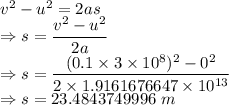
Physics, 18.02.2020 06:26 tasnimabdallah971
Electric fields up to 2.00 × 10 5 N/C have been measured inside of clouds during electrical storms. Neglect the drag force due to the air in the cloud and any collisions with air molecules. (a) What acceleration does the maximum electric field produce for protons in the cloud? Express your answer in SI units and as a fraction of g. (b) If the electric field remains constant, how far will the proton have to travel to reach 10% of the speed of light ( 3.00 × 10 8 m/s) if it started with negligible speed? (c) Can you neglect the effects of gravity? Explain your answer.

Answers: 2
Another question on Physics

Physics, 21.06.2019 22:00
Air is held within a frictionless piston-cylinder container, which is oriented vertically. the mass of the piston is 0.45 kg and the cross-sectional area is 0.0030 m2. initially (state 1) the pressure of the gas is sufficient to support the weight of the piston as well as the force exerted by the atmospheric pressure ( 101.32 kpa). the volume occupied by the air within the cylinder in state 1 is 1.00 liter. one end of a spring (with spring constant k = 1000 n/m) is attached to the top of the piston, while the other end of the spring is attached to a stage that can move vertically. initially the spring is undeflected and therefore exerts no force. then the stage is then moved quasistatically downward a distance of 10.0 cm, at which point the system reaches state 2. the piston-cylinder is not insulated; rather it remains in diathermal contact with the surroundings, which are at a constant temperature of 300 k. what is the change of pressure within the container?
Answers: 3

Physics, 22.06.2019 04:00
Several mountains together form a mountain . a few of these combined form a mountain system. several systems combined form a mountain , which can stretch thousands of miles in length.
Answers: 2

Physics, 22.06.2019 08:00
While studying chemical reactions and conservation of matter, sarah's class conducted a variety of experiments. sarah and her lab partner found the mass of a wax candle and placed the candle in a flask. the students lit the candle and let it burn to completion. all that was left was wax and charred candle wick. per their teacher's instructions, the students found the mass of the products. their data can be seen in the data table. formulate a hypothesis the students could test to explain why the experiment did not support the law of conservation of matter. a) the students could repeat the experiment using different candles; there might have been a flaw in the candle. b) the experiment should be repeatable. the students should run several trials and then take an average of the after mass in each trial. c) the students should have someone in the class check their measurement skills as they repeat the experiment. they may have made an error using the balance. d) the students should burn the candle in a container that has some type of lid so that any gas that is a product of the reaction can be contained and massed. submit
Answers: 2

Physics, 22.06.2019 09:00
One form of energy can be another type of energy. a. created to form b. transformed into c. destroyed and then created to form
Answers: 1
You know the right answer?
Electric fields up to 2.00 × 10 5 N/C have been measured inside of clouds during electrical storms....
Questions










Mathematics, 03.08.2019 15:30

Geography, 03.08.2019 15:30

Mathematics, 03.08.2019 15:30




English, 03.08.2019 15:30

Geography, 03.08.2019 15:30



 or
or 









